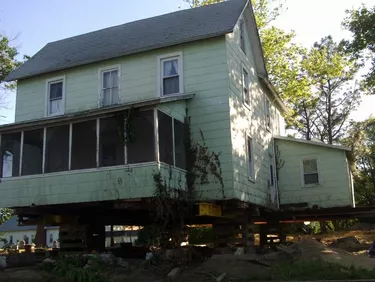
If you know what you're doing, flipping houses may be a profitable undertaking. Finding and buying used houses for sale to be moved can be a smart way to get houses with unique appeal for a cheaper price. Moving an older house as little as farther back from the road or as far as several miles away may drastically increase its resale value. There are limitations on how far a house can be moved, however, and not every house is worth moving, but if you find the combination of an affordable older house and a perfect new site for it, this is an achievable project.
How Are Houses Moved?
Video of the Day
The process is surprisingly straightforward but also requires significant advance planning. Wolfe House & Building Movers warns that moving an entire house is not a spur-of-the-moment undertaking. The first step you must take is to ensure that the building is sound. You shouldn't try to move a house with structural damage. Once you've ensured its stability, holes are cut into the foundation and a frame of steel beams is inserted, creating a rigid frame.
Video of the Day
This frame is then jacked up and placed on cribbing (box-like stacks of beams that support a structure in an elevated position) and the jacks are repositioned on foam rollers, which allows the movers to tilt or rotate the house through careful coordination. From here, the house is gently transitioned onto a large flatbed truck using rollers and driven to its new location, where the process is reversed to precisely position the house on top of its new footings.
Necessary Preparations to Move a House
The footings at a moved house's new location must be prepared well in advance of actually moving the house, and the route along which the house is moved must be cleared of obstructions such as low-hanging trees or power lines. Most municipalities require permits to be filed for the procedure, and your house-moving company should coordinate with utility companies to ensure that the route is clear.
According to Realtor.com, moving a house will cost between $12 and $16 per square foot, averaging out at $14 per square foot. Permits can cost somewhere between 10 to 30 percent of the total moving costs and in some regions may cost as much as $200,000.
Areas with more tree coverage, tightly packed houses and hillier terrain will all factor into how far you can move a house. The vast majority of house moves are less than four miles from their original location, primarily along the eastern coast of the United States. In the Midwest, where there are vast wide tracks of land, some houses can be moved 40 miles or more, but they are the minority.
Which Houses Can or Should be Moved
Not all houses are viable targets for moving, however. First, there is the financial barrier – physically picking up and moving a house isn't cheap and you must consider whether it would be cheaper to invest in a new house or a different one altogether. An ideal house to buy and move is one that wouldn't need to go far, maybe farther from the street or onto newer and less damaged footings/basements. Finding used houses for sale to be moved can be difficult, as well.
Next, there is the practical consideration of the house's structural stability – large cracks or damaged supports will often preclude the possibility of lifting and moving a house, though your moving contractors will best be able to tell you what is or is not viable. Stone and brick will be less forgiving than wooden structures.
Popular Mechanics identified some other practicalities in the form of disconnecting and reconnecting utilities for the relocated house. If you are building new footings, you'll need to consider how accessible the new location is for power, water and sewage as well as gas, if applicable.